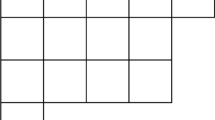Abstract
The Papangelou intensities of determinantal (or fermion) point processes are investigated. These exhibit a monotonicity property expressing the repulsive nature of the interaction, and satisfy a bound implying stochastic domination by a Poisson point process. We also show that determinantal point processes satisfy the so-called condition (σ λ), which is a general form of Gibbsianness. Under a continuity assumption, the Gibbsian conditional probabilities can be identified explicitly.
Similar content being viewed by others
References
R. Bhatia (1997) Matrix Analysis Springer New York
A. Borodin A. Okounkov G. Olshanski (2000) ArticleTitleAsymptotics of Plancherel measures for symmetric groups J. Am. Math. Soc. 13 IssueID3 481–515
A. Borodin and G. Olshanski, Point processes and the infinite symmetric group, Part VI: Summary of results, available online at URL http://arxiv.org/abs/math.RT/9810015
D. J. Daley D. Vere-Jones (1988) An Introduction to the Theory of Point Processes Springer-Verlag New York
H.-O. Georgii T. Küneth (1997) ArticleTitleStochastic comparison of point random fields J. Appl. Prob. 34 868–881
E. Glötzl (1981) ArticleTitleKonstruktion der bedingten Energie eines Punktprozesses Serdica 7 217–233
G. Grimmett (1999) Percolation EditionNumber2 Springer Berlin
P. R. Halmos V. S. Sunder (1978) Bounded Integral Operators on L2Spaces Springer-Verlag Berlin
Y. G. Kondratiev T. Kuna (2003) ArticleTitleCorrelation functions for Gibbs measures and Ruelle bounds Methods Funct. Anal.Topology 9 9–58
O. K. Kozlov (1976) ArticleTitleGibbsian description of point random fields Theory Prob. Appl. 21 339–355
R. Lyons (2003) ArticleTitleDeterminantal probability measures Publ. Math. Inst. HautesÉtudes Sci. 98 167–212
R. Lyons J. E. Steif (2003) ArticleTitleStationary determinantal process: Phase multiplicity, Bernoullicity, entropy, and domination Duke Math. J. 120 IssueID3 515–575
O. Macchi (1975) ArticleTitleThe coincidence approach to stochastic point processes Adv. Appl. Prob. 7 83–122
K. Matthes W. Warmuth J. Mecke (1979) ArticleTitleBemerkungen zu einer Arbeit von Nguyen Xuan Xanh und Hans Zessin Math. Nachr. 88 117–127
J. Mecke (1967) ArticleTitleStationäre zufällige Maβe auf lokalkompakten abelschen Gruppen Z. Wahrscheinlichkeitstheorie verw. Geb 9 36–58
R. Meester and R. Roy, Continuum Percolation (Cambridge University Press, 1996).
X. X. Nguyen H. Zessin (1979) ArticleTitleIntegral and differential characterizations of the Gibbs process Math. Nachr. 88 105–115
M. Ohya D. Petz (1993) Quantum Entropy and its Use Springer-Verlag Berlin
F. Papangelou (1974) ArticleTitleThe conditional intensity of general point processes and an application to line processes Z. Wahrscheinlichkeitstheorie verw. Geb. 28 207–226
C. J. Preston (1976) ArticleTitleSpatial birth-and-death processes Bull. Inst. Int. Statist. 46 371–391
C. J. Preston (1976) Random Fields,Lecture Notes in Mathematics Springer Verlag Berlin
M. Reed B. Simon (1975) Methods of Modern Mathematical Physics II: Fourier Analysis, Self-Adjointness Academic Press New York
H. Shimomura (1994) ArticleTitlePoisson measures on the configuration space and unitary representations of the group of diffeomorphisms J.Math. Kyoto Univ. 34 IssueID3 599–614
T. Shirai Y. Takahashi (2003) ArticleTitleRandom point field associated with certain Fredholm determinant I: fermion, poisson, and boson point processes J. Funct. Anal. 205 414–463
T. Shirai Y. Takahashi (2003) ArticleTitleRandom point field associated with certain Fredholm determinant II: fermion shift and its ergodic and Gibbs properties Ann. Prob. 31 1533–1564
T. Shirai H. J. Yoo (2002) ArticleTitleGlauber dynamics for fermion point processes Nagoya Math. J. 168 139–166
B. Simon (1979) Trace Ideals and Their Applications Cambridge University Press Cambridge
A. Soshnikov (2000) ArticleTitleDeterminantal random point fields Russ.Math. Surv. 55 923–975
H. Spohn, Interacting brownian particles: A study of Dyson’s model, in,Hydrodynamic behaviour and interacting particle systems (Minneapolis, Minn., 1986),G. Papanicolaou, ed., IMA Vol. Math. Appl. 9 (1987).
H. Spohn (1987) ArticleTitleTracer dynamics in Dyson’s model of interacting brownian particles J. Stat. Phys. 47 669–679
V. Strassen (1965) ArticleTitleThe existence of probability measures with given marginals Ann. Math. Statist. 36 423–439
H. J. Yoo, Gibbsianness of fermion random point fields,Preprint (2003).
Author information
Authors and Affiliations
Corresponding author
Rights and permissions
About this article
Cite this article
Georgii, HO., Yoo, H.J. Conditional Intensity and Gibbsianness of Determinantal Point Processes. J Stat Phys 118, 55–84 (2005). https://doi.org/10.1007/s10955-004-8777-5
Received:
Accepted:
Issue Date:
DOI: https://doi.org/10.1007/s10955-004-8777-5



